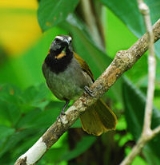
Buff-throated Saltator
Encyclopedia
The Buff-throated Saltator, Saltator maximus, is a seedeating bird. Traditionally placed in the cardinal family
(Cardinalidae), it actually seems to be closer to the tanager
s (Thraupidae). It breeds from southeastern Mexico
to western Ecuador
and northeastern Brazil
.
This is the type species
of Saltator
. Consequently, it and its closest allies would retain the genus name when this apparently polyphyletic group is eventually split up.
The Buff-throated Saltator is on average 20 cm long and weighs 42-52 g. The adult has a slate-grey head with a white supercilium
and a greenish crown. The upperparts are olive green, the underparts are grey becoming buff on the lower belly, and the throat is buff, edged with black. The thick convex bill and legs are black. Young birds are duller, and have a white-mottled blackish throat and breast, and brown markings on the lower underparts.
The common call is a high seeeer. Males duet melodiously with a warbled cheery cheery answered by cheery to you.
This is a species of dense vegetation. The Buff-throated Saltator feeds on fruit, buds, nectar and slow-moving insects. It forages at low and mid levels, sometimes with mixed species flocks
.
The two pale blue eggs per clutch
measure some 22–32 mm long by about 16.5-21.5 mm wide and weigh about 4.8-6.1 grams each. They are laid in a bulky cup nest up to 2 m high in a tree or bush.
Cardinal (bird)
The Cardinals or Cardinalidae are a family of passerine birds found in North and South America. The South American cardinals in the genus Paroaria are placed in another family, the Thraupidae ....
(Cardinalidae), it actually seems to be closer to the tanager
Tanager
The tanagers comprise the bird family Thraupidae, in the order Passeriformes. The family has an American distribution.There were traditionally about 240 species of tanagers, but the taxonomic treatment of this family's members is currently in a state of flux...
s (Thraupidae). It breeds from southeastern Mexico
Mexico
The United Mexican States , commonly known as Mexico , is a federal constitutional republic in North America. It is bordered on the north by the United States; on the south and west by the Pacific Ocean; on the southeast by Guatemala, Belize, and the Caribbean Sea; and on the east by the Gulf of...
to western Ecuador
Ecuador
Ecuador , officially the Republic of Ecuador is a representative democratic republic in South America, bordered by Colombia on the north, Peru on the east and south, and by the Pacific Ocean to the west. It is one of only two countries in South America, along with Chile, that do not have a border...
and northeastern Brazil
Brazil
Brazil , officially the Federative Republic of Brazil , is the largest country in South America. It is the world's fifth largest country, both by geographical area and by population with over 192 million people...
.
This is the type species
Type species
In biological nomenclature, a type species is both a concept and a practical system which is used in the classification and nomenclature of animals and plants. The value of a "type species" lies in the fact that it makes clear what is meant by a particular genus name. A type species is the species...
of Saltator
Saltator
Saltator is a genus of songbirds of the Americas. They are traditionally placed in the cardinal family but now seem to be closer to tanagers . Their English name is also saltator, except for two dark species known by the more general grosbeak.Saltator is Latin for "leaper" or "dancer"...
. Consequently, it and its closest allies would retain the genus name when this apparently polyphyletic group is eventually split up.
The Buff-throated Saltator is on average 20 cm long and weighs 42-52 g. The adult has a slate-grey head with a white supercilium
Supercilium
The supercilium is a plumage feature found on the heads of some bird species. It is a stripe which runs from the base of the bird's beak above its eye, finishing somewhere towards the rear of the bird's head. Also known as an "eyebrow", it is distinct from the eyestripe, which is a line which runs...
and a greenish crown. The upperparts are olive green, the underparts are grey becoming buff on the lower belly, and the throat is buff, edged with black. The thick convex bill and legs are black. Young birds are duller, and have a white-mottled blackish throat and breast, and brown markings on the lower underparts.
The common call is a high seeeer. Males duet melodiously with a warbled cheery cheery answered by cheery to you.
This is a species of dense vegetation. The Buff-throated Saltator feeds on fruit, buds, nectar and slow-moving insects. It forages at low and mid levels, sometimes with mixed species flocks
Mixed-species feeding flock
A mixed-species feeding flock, also termed a mixed-species foraging flock, mixed hunting party or informally bird wave, is a flock of usually insectivorous birds of different species, that join each other and move together while foraging...
.
The two pale blue eggs per clutch
Clutch (eggs)
A clutch of eggs refers to all the eggs produced by birds or reptiles, often at a single time, particularly those laid in a nest.In birds, destruction of a clutch by predators, , results in double-clutching...
measure some 22–32 mm long by about 16.5-21.5 mm wide and weigh about 4.8-6.1 grams each. They are laid in a bulky cup nest up to 2 m high in a tree or bush.
External links
- Buff-throated Saltator videos on the Internet Bird Collection
- Buff-throated Saltator photo gallery VIREO Photo-High Res--(Close-up)
- Photo-Medium Res; Article www.ib.usp.br—"Cardinalidae"
- Photo-Very High Res--(Close-up); Article pbase.com–"Panama Birding"

